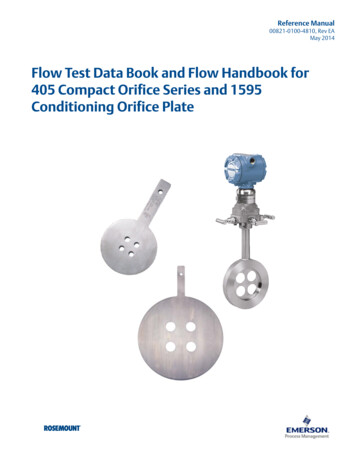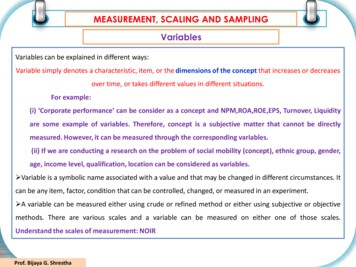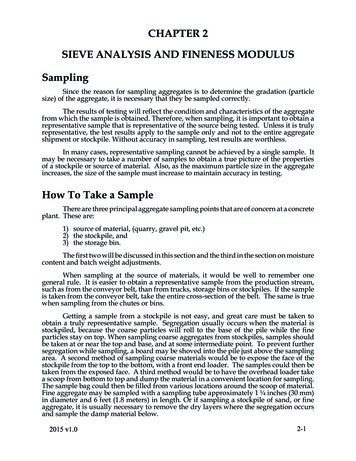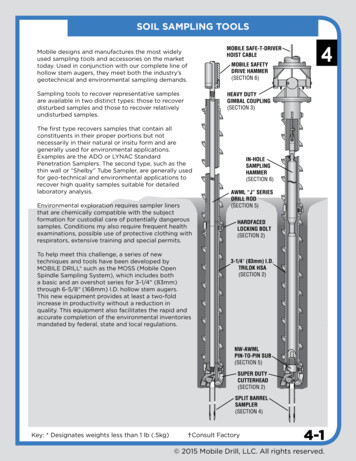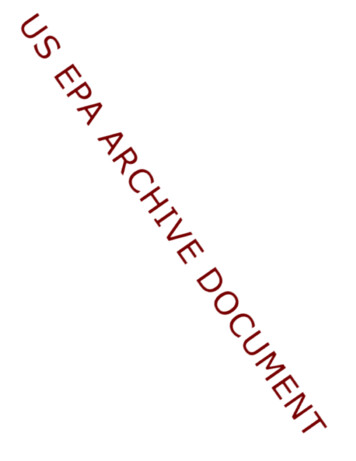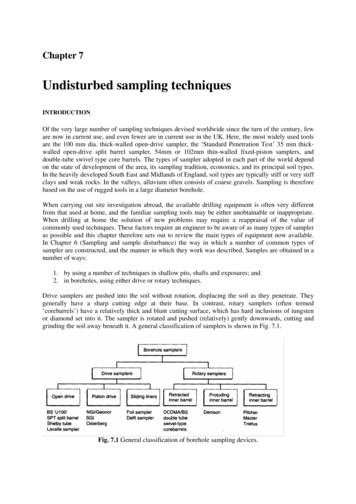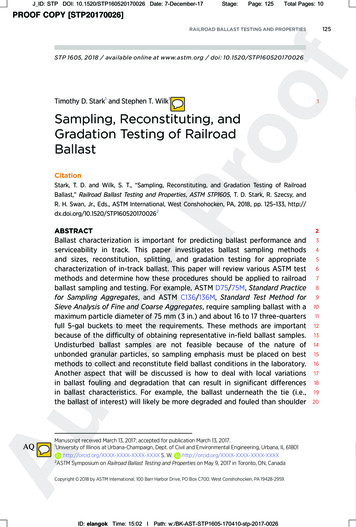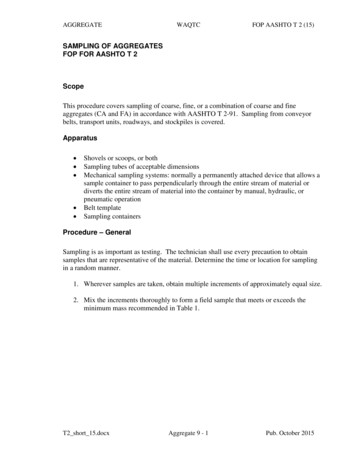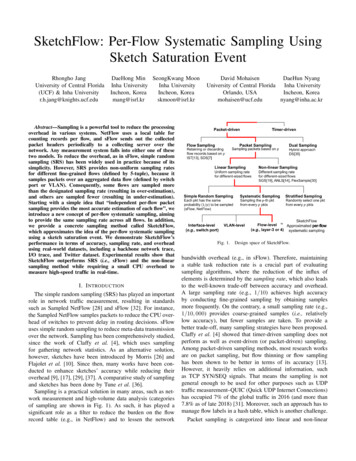
Transcription
SketchFlow: Per-Flow Systematic Sampling UsingSketch Saturation EventRhongho JangUniversity of Central Florida(UCF) & Inha Universityr.h.jang@knights.ucf.eduDaeHong Min SeongKwang MoonInha UniversityInha UniversityIncheon, KoreaIncheon, Koreaskmoon@isrl.krmang@isrl.krAbstract—Sampling is a powerful tool to reduce the processingoverhead in various systems. NetFlow uses a local table forcounting records per flow, and sFlow sends out the collectedpacket headers periodically to a collecting server over thenetwork. Any measurement system falls into either one of thesetwo models. To reduce the overhead, as in sFlow, simple randomsampling (SRS) has been widely used in practice because of itssimplicity. However, SRS provides non-uniform sampling ratesfor different fine-grained flows (defined by 5-tuple), because itsamples packets over an aggregated data flow (defined by switchport or VLAN). Consequently, some flows are sampled morethan the designated sampling rate (resulting in over-estimation),and others are sampled fewer (resulting in under-estimation).Starting with a simple idea that “independent per-flow packetsampling provides the most accurate estimation of each flow”, weintroduce a new concept of per-flow systematic sampling, aimingto provide the same sampling rate across all flows. In addition,we provide a concrete sampling method called SketchFlow,which approximates the idea of the per-flow systematic samplingusing a sketch saturation event. We demonstrate SketchFlow’sperformance in terms of accuracy, sampling rate, and overheadusing real-world datasets, including a backbone network trace,I/O trace, and Twitter dataset. Experimental results show thatSketchFlow outperforms SRS (i.e., sFlow) and the non-linearsampling method while requiring a small CPU overhead tomeasure high-speed traffic in real-time.I. I NTRODUCTIONThe simple random sampling (SRS) has played an importantrole in network traffic measurement, resulting in standardssuch as Sampled NetFlow [28] and sFlow [32]. For instance,the Sampled NetFlow samples packets to reduce the CPU overhead of switches to prevent delay in routing decisions. sFlowuses simple random sampling to reduce meta-data transmissionover the network. Sampling has been comprehensively studied,since the work of Claffy et al. [4], which uses samplingfor gathering network statistics. As an alternative solution,however, sketches have been introduced by Morris [26] andFlajolet et al. [10]. Since then, many works have been conducted to enhance sketches’ accuracy while reducing theiroverhead [9], [17], [29], [37]. A comparative study of samplingand sketches has been done by Tune et al. [36].Sampling is a practical solution in many areas, such as network measurement and high-volume data analysis (categoriesof sampling are shown in Fig. 1). As such, it has played asignificant role as a filter to reduce the burden on the flowrecord table (e.g., in NetFlow) and to lessen the networkDaeHun NyangDavid MohaisenInha UniversityUniversity of Central FloridaIncheon, KoreaOrlando, USAnyang@inha.ac.krmohaisen@ucf.eduFig. 1.Design space of SketchFlow.bandwidth overhead (e.g., in sFlow). Therefore, maintaininga stable task reduction rate is a crucial part of evaluatingsampling algorithms, where the reduction of the influx ofelements is determined by the sampling rate, which also leadsto the well-known trade-off between accuracy and overhead.A large sampling rate (e.g., 1/10) achieves high accuracyby conducting fine-grained sampling by obtaining samplesmore frequently. On the contrary, a small sampling rate (e.g.,1/10, 000) provides coarse-grained samples (i.e., relativelylow accuracy), but fewer samples are taken. To provide abetter trade-off, many sampling strategies have been proposed.Claffy et al. [4] showed that timer-driven sampling does notperform as well as event-driven (or packet-driven) sampling.Among packet-driven sampling methods, most research worksare on packet sampling, but flow thinning or flow samplinghas been shown to be better in terms of its accuracy [13].However, it heavily relies on additional information, suchas TCP SYN/SEQ signals. That means the sampling is notgeneral enough to be used for other purposes such as UDPtraffic measurement–QUIC (Quick UDP Internet Connections)has occupied 7% of the global traffic in 2016 (and more than7.8% as of late 2018) [31]. Moreover, such an approach has tomanage flow labels in a hash table, which is another challenge.Packet sampling is categorized into linear and non-linear
sampling, per Fig. 1. The linear sampling is featured byuniformly sampling 1/p packets of a data stream, where p isthe sampling interval and 1/p is the sampling rate. Accordingto Claffy et al. [4], the simple random sampling, stratifiedsampling, and systematic sampling can be applied as samplingstrategies. Recent works have focused on how to apply a nonlinear sampling rate according to the flow size [14], [19],[30], where mouse flows get sampled more often and elephantflows less often using a non-linear function based on the flowsize. On the downside, the non-linearity in the sampling ratesubstantially increases the overhead by sampling small flowsheavily to guarantee the accuracy for a traffic distribution.Sketches are compact data structures that use probabilistic counters for approximate estimation of spectral densitiesof flows [5], [18], [21]–[23], [29]. Sketch-based algorithmshave been shown more accurate in estimation than samplingapproaches while using a small amount of memory. Thehigher accuracy of sketches is owing to its per-flow nature ofestimation. However, research on sketch-based estimation hasmainly focused on the sketch itself: the very nature of sketchto use only a small amount of memory prohibits it from beingused for processing large scale data. More specifically, once asketch is saturated, it cannot count at all. Consequently, sketchbased measurement algorithms have been used in a limitedway such as for anomaly detection (e.g., heavy hitter, superspreader, etc.) within a short time frame [15], [22], [24], [39].Also, decoding a sketch is computational heavy, thus cannotbe done in data-plane, and thus sketches usually are deliveredto a server with enough computing power for decoding, whichinevitably introduces a control loop delay.Our goal is to design a new sketch-based sampling algorithm, called SketchFlow, to provide a better trade-off betweenaccuracy and overhead for a given sampling rate of 1/p.SketchFlow performs an approximated systematic samplingfor fine-grained flows (e.g., layer-4 flows) independently. Asa result, almost exactly 1/p packets from each and everyflow will be sampled. This property is in contrast to SRS, inwhich the sampling rate across different flows in a data streamis not guaranteed. SketchFlow provides a high estimationaccuracy, processes high-speed data in real-time, and is generalenough to be used for many estimation purposes without anyapplication-specific information. The core idea of SketchFlowis to recognize a sketch saturation event for a flow and sampleonly the triggering packets. The saturated sketch for the flowis reset so that it can be reused. Therefore, SketchFlow can beseen as a sampler as well as a sketch. SketchFlow, however,does not work alone as a sketch measuring the whole datastream, but as a general sampler to NetFlow and sFlow.In summary, our contributions in this paper are as follows:i We introduce the new notion of per-flow systematic packetsampling for a precise sampling. See Fig. 1 for how ourcontribution fits within the literature. ii We propose a newframework using the per-flow sketch saturation event as asampling signal of the flow, whereby only a signaling packet issampled from the flow, and the saturated sketch is emptied forthe next round sampling. This use of a sketch as a sampler isnew in the sense that a per-flow sketch now works as a per-flowsystematic sampler, and the sketch saturation is not any morean issue. We note, however, that a sketch is an approximateper-flow counter thus a sampling algorithm under the framework is only an approximate per-flow systematic sampler.A new instance can be designed using any better sketchwhen available. iii We realize an approximate version of perflow systematic packet sampling called SketchFlow. For thispurpose, a new per-flow sketch algorithm is presented, whichcan encode and decode flows in real-time. Multi-layer sketchdesign is applied for scalable sampling. iv We demonstrateSketchFlow’s performance in terms of the stable sampling rate,accuracy, and overhead using real-world datasets, includinga backbone network trace, hard disk I/O trace, and Twitterdataset.II. M OTIVATION : F LOW- AWARE S AMPLING VS .F LOW- OBLIVIOUS S AMPLINGThe bottleneck of NetFlow is the processing capacity forthe local table, and that of sFlow is the network capacity.To address the bottleneck, the widely-adopted simple randomsampling (SRS) is used with a very small overhead. Intheory, SRS guarantees each packet has an equal chance to besampled. However, the general usage of SRS is for samplingover the interface or VLAN, which collects coarse sampleswithout considering the individual fine-grained flows, such asa flow defined by the 5-tuple. Consequently, some flows aresampled more than the designated sampling rate, resulting inover-estimation, while others suffer from under-estimation. Wenote that, although the main purpose of traffic measurement ismostly to obtain per-flow statistics such as the spectral densityof flow size and distribution, sampling has been applied to datastreams aggregating all the flows, rather than individual flows.SRS samples packets with 1/p over the entire data stream,although it cannot guarantee the sampling rate to be 1/pfor each flow. For per-flow statistics, however, the estimationaccuracy is ideal when exactly f /p packets for each flow aresampled (See the solid lines in Fig. 2), where f is the flowsize and 1/p is the sampling rate. If more or fewer packetsthan f /p are sampled for a flow, it leads to over- or underestimation of the actual flow size, because the number of thesampled packets is multiplied by p to estimate f . Therefore,the best strategy is to keep the per-flow sampling rate identicalacross flows. To that end, we propose the per-flow systematicpacket sampling, which is a method to sample every p-thpacket within a flow, whereas the well-known packet-levelsystematic sampling is to sample every p-th packet over theentire data stream. Fig. 2(a) shows the number of sampledpackets according to flow size for a given sampling rate. Thesampling quality is captured by how close the grey dot (thenumber of actually-sampled packets) is from the solid line (thenumber of ideally-sampled packets) in this figure. Here, we seethat the sampling quality of the flow-oblivious sampling, suchas the simple random sampling (i.e., SRS), is much poorer thanthat of the per-flow systematic sampling (i.e., ideal), which isa flow-aware sampling algorithm ( i ).
(a) Flow-oblivious sampling(b) Flow-aware samplingFig. 2. Number of sampled packets compared to exact per-flow systematicsampling (i.e., ideal): the estimation of SketchFlow is more accurate than thesimple random sampling (SRS).The complexity of the per-flow systematic sampling problem is equivalent to the per-flow counting problem, whichmeans we still have to pay a large amount of memory/computations for the flow table (i.e., fail to reduce thecomplexity). To address this issue, we propose a sketchsaturation-driven per-flow systematic sampling framework.Our framework utilizes a sketch to reduce the complexity ofthe per-flow counting problem. The sketch in the framework,however, is used to estimate a sampling interval of a flow,rather than the flow size. Therefore, the sketch does not needto be large to hold the whole flows’ total length, but it wouldbe sufficient even when small because it holds only concurrentflows’ sampling intervals and resets. When a packet arrives,the sketch encoding algorithm recognizes its flow to sketchindividual flows on a small memory in real-time. When thesketch space is saturated, the triggering packet is sampled to aflow table (e.g., NetFlow) or to a collector (e.g., sFlow), andthe saturated sketch is emptied for the next round sampling.One can build a per-flow systematic packet sampling algorithmeasily from the generic framework by defining an onlineencodable/decodable sketch algorithm. Since a sketch for perflow estimation of the sampling interval has an approximatecounting structure, a sampling algorithm from the frameworkis an approximate version of the per-flow systematic sampling,providing a very high accuracy in per-flow statistics whilereducing the overhead (both tables and network bandwidth)by keeping the sampling rate consistent across flows ( ii ).SketchFlow is a concrete example of the framework.Fig. 2(b) illustrates the accuracy of SketchFlow. For each flow,the fraction of the sampled packet number over the flow sizeis almost equivalent to the sampling rate of 1/p. Moreover, thevariance of SketchFlow is much smaller than flow-oblivioussampling schemes (Fig. 2(a)). In addition, SketchFlow canprovide mouse flow samples by stacking these flows to triggersampling events (See section V-D). To sum up, legacy SRScan be replaced by SketchFlow in many applications such asnetwork monitoring (e.g., NetFlow and sFlow), big data analytics (e.g., PowerDrill [12]), and social network service dataanalysis (e.g., Twitter and Facebook) for better performance.III. S KETCH - BASED P ER - FLOW S YSTEMATIC S AMPLINGWe present SketchFlow, an instance of our framework usingper-flow sketch to trigger per-flow sampling. SketchFlow is anFig. 3.The overview of SketchFlowapproximate per-flow systematic sampling ( iii ).A. Encoding: Data Structure and OverviewFig. 3 shows an overview of SketchFlow designed to perform an approximate per-flow sampling using a small amountof memory. We constructed SketchFlow using a word array,which is initialized to all 0’s. When a flow f arrives, a wordfrom the word array will be selected using the 5-tuple hashvalue h(f ) ( 1 ) , and then s bits of the register (i.e., vectormask) are allocated to f according to the partial output (slidingwindow) of h(f ) ( 2 ). The virtual vector is extracted by doing“Bitwise AND” between register and vector mask ( 4 ). Foreach packet from f , a randomization technique [29] is usedfor multiplicity counting. That is, one bit position of the vectoris randomly flipped to 1 by 3 - 5 . A sampling event of eachflow is triggered when the usage of the vector exceeds its limit(i.e., vector saturation) ( 6 ), and then the estimated value ofthe average number of packets to saturate the vector becomesthe sampling interval p̂. In SketchFlow, Linear counting (LC)is used for volume estimation by p̂ m ln(V ), where m isthe number of bits (or memory size), and V is the fractionof 0’s remaining in the vector. Our approach is consistentwith the theory of LC, while inheriting its limitations—thatis, LC guarantees accuracy only before 70% of a vector isexhausted [37]. After a sampling event, the vector is recycled (reset to 0) in anticipation of the next round samplingevent ( 7 ). By doing so, the reduction ratio of each flow(equivalently, the sampling rate) is approximately 1/p̂. Dueto the constrained memory space, however, vectors have to bedesigned to share bit positions with one another (virtual vectorhereafter), which brings about a major challenge, the noiseowing to virtual vector collisions. That is, multiple concurrentflows fall in a race condition when claiming bits in shared bitpositions. We carefully designed the sketch to take a noise-freeapproach by minimizing the race condition (See section III-C).
B. Decoding: Sampling TriggerUnderstanding the Saturation Event. A sampling event istriggered by the saturation of a virtual vector assigned to eachflow, and the usage of virtual vector is monitored whenever apacket is encoded into it. The packet that triggers the saturationevent of a vector (hereafter, signaling bit) is one that flips a0’s position to 1 and eventually causes more than 70% usageof the vector. We observed that the LC’s formula could not bedirectly applied here, because it overestimates the number ofpackets encoded in the virtual vector. The key reason is that thelast packet in a 70% marked vector is highly likely to remarkthe bit already marked in LC, whereas the signaling bit marksa fresh 0’s bit in our sketch. We note that this estimation gapdoes not mean that LC is wrong, but event-driven samplingtrigger (i.e., signaling bit) was not intended by LC.Saturation Event-based Estimation (Sampling Interval).Here, we propose a new formula to calculate the estimationconsidering the saturation event, which is the basis of the realtime sampling.Theorem 1: Considering the saturation event that triggerssetting the (s z 1)-th signaling bit in a virtual vector of sizes, the sampling interval of a flow, p̂ is calculated as follows: τ1 Vs zln Vzτ τ · Vs z ,(1)p̂ 1 Vs zln (1 1s )where z (Vz ) is the fraction of 0’s in a virtual vector, τ is apositive constant, and s is the vector size. For convenience,we consider the first term as f (z) and the second as g(z).Proof: The equation consists of two parts: the formermodifies the LC’s formula without truncating the minor terms,and the latter is the probabilistic expectation by consideringthe saturation event. Let n be the number of packets and n̂ bethe estimation of packets. In appendix A in [37], Wang et al.derived the mean of the random variable Un which representsthe number of 0’s in the bit map, or a virtual vector. Let Aj bean event that the j-th bit is 0, and let 1Aj be the correspondingindicator randomvariable. Then, since Un is the number ofPs0’s, Un j 1 1Aj , where s is the size of the vector. Finally,per [37], we have the following.sXn̂E(Un ) P (Aj ) s · (1 1/s) ,(2)j 1where P (Aj ) is the probability of Aj . Since the assignmentn̂of the bits is independent, P (Aj ) (1 1/s) .They approximate this equation to a convergence valuewhen s and n go to infinity. However, for a more preciseestimation, Nyang et al. [29] used the non-approximationestimation derived from the expectation of Un , which is usedas f (z) for better accuracy, because the frequent accumulationof small estimation error can grow bigger. They obtainedn̂Vz (1 1/s) ,(3)where Vz is the fraction of 0’s in the vector, that is, E(Un )/s.And by taking the log, they deducedln Vz n̂ · ln (1 1/s).(4)We choose n̂ as f (z), because n̂ is the estimation of packetswhen there are z zeros in the vector. Note that the first partf (z) is not a cumulative sum of the second part g(z) becausez is the number of zeros before the signaling bit flips to 1’s.Let g(z) be the expected number of packets required forsaturation after a virtual vector state reaches to the state havingz 1 zero bits from z zero bits. We assume that g(z) isthe number of packets needed to make the event. This meansthat the first g(z) 1 packets did not convert a new 0-bit to1, and the last g(z)-th packet selects the 0-bit in the virtualvector. The probability of the former is Vs z , the fraction of1’s in the virtual vector v, and the latter Vz , the fraction of0’s in v; namely, Vz equals 1 Vs z . Since g(z) must be apositive integer, we can expect g(z) from 1 to some extent, τ .Therefore, we get the following expectation:τ 12g(z) Vz 2Vz Vs z 3Vz Vs z · · · τ Vz Vs zττX 1 Vs zi 1τ τ · Vs z. iVz Vs z 1 Vs zi 1The last term in the above equation is obtained from g(z) Vs z · g(z). Vz in g(z) is canceled out by dividing both sidesby Vz ; that is, 1 Vs z . In this paper, we set the number of trials (τ ) to 8 becauseit has 95% of confidence on flipping a new 0’s to 1’s fromhaving z zeros. A random variable K follows the binomialdistribution with parameters τ and Vz , where τ is the numberof trials (or packets) and Vz
II. MOTIVATION: FLOW-AWARE SAMPLING VS. FLOW-OBLIVIOUS SAMPLING The bottleneck of NetFlow is the processing capacity for the local table, and that of sFlow is the network capacity. To address the bottleneck, the widely-adopted simple random sampling (SRS) is used with a very small overhea

